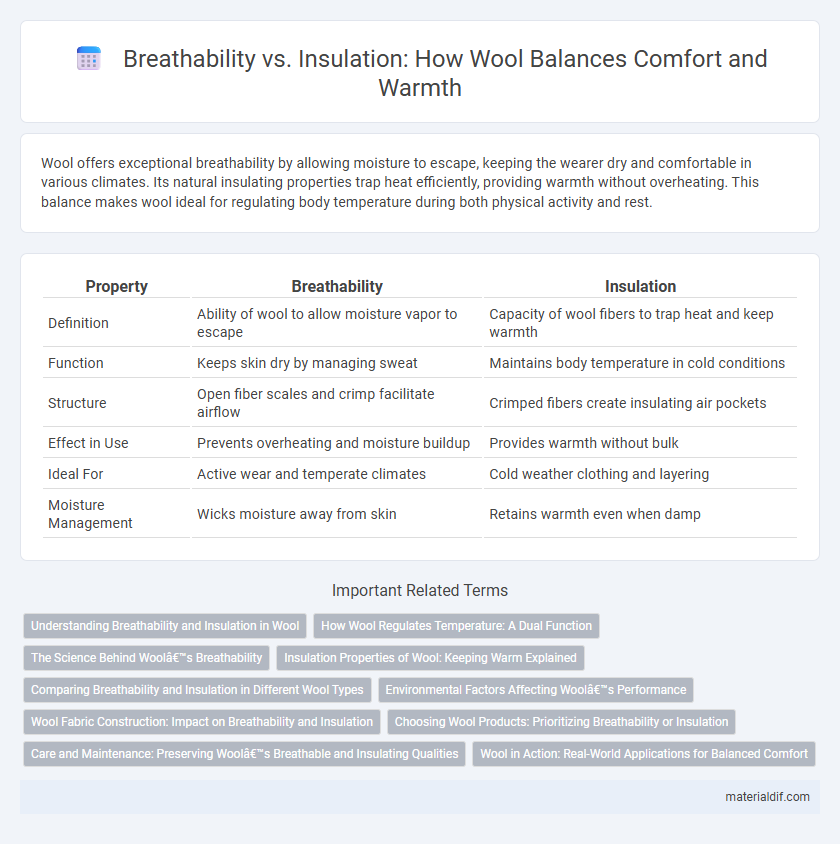Wool offers exceptional breathability by allowing moisture to escape, keeping the wearer dry and comfortable in various climates. Its natural insulating properties trap heat efficiently, providing warmth without overheating. This balance makes wool ideal for regulating body temperature during both physical activity and rest.
Table of Comparison
| Property | Breathability | Insulation |
|---|---|---|
| Definition | Ability of wool to allow moisture vapor to escape | Capacity of wool fibers to trap heat and keep warmth |
| Function | Keeps skin dry by managing sweat | Maintains body temperature in cold conditions |
| Structure | Open fiber scales and crimp facilitate airflow | Crimped fibers create insulating air pockets |
| Effect in Use | Prevents overheating and moisture buildup | Provides warmth without bulk |
| Ideal For | Active wear and temperate climates | Cold weather clothing and layering |
| Moisture Management | Wicks moisture away from skin | Retains warmth even when damp |
Understanding Breathability and Insulation in Wool
Wool fibers naturally create tiny air pockets that facilitate breathability by allowing moisture vapor to escape, keeping the wearer dry and comfortable. At the same time, wool's crimped structure traps heat, providing excellent insulation even when wet. This unique combination makes wool highly effective for regulating body temperature in a variety of climates and activities.
How Wool Regulates Temperature: A Dual Function
Wool regulates temperature through its unique fiber structure that allows breathability while providing excellent insulation. The natural crimp in wool fibers creates air pockets that trap heat, maintaining warmth in cold conditions, while its moisture-wicking properties enable breathability by dispersing sweat and allowing air circulation. This dual functionality makes wool an ideal material for both regulating body temperature and enhancing comfort across diverse climates.
The Science Behind Wool’s Breathability
Wool fibers contain microscopic scales and natural crimp that create tiny air pockets, allowing for exceptional breathability and moisture wicking while maintaining insulation. This unique structure traps heat close to the body yet permits moisture vapor to escape, preventing overheating and dampness. The result is a fabric that adapts to temperature changes, keeping wearers comfortable across a range of environmental conditions.
Insulation Properties of Wool: Keeping Warm Explained
Wool's unique insulation properties stem from its natural crimp, which traps air and creates an effective barrier against cold temperatures. This air retention enables wool to maintain warmth even when damp, making it superior to many synthetic fibers for thermal regulation. Its moisture-wicking ability also helps manage body heat by drawing sweat away from the skin, preventing chill and enhancing overall comfort in cold environments.
Comparing Breathability and Insulation in Different Wool Types
Merino wool excels in breathability due to its fine fibers that regulate moisture effectively, making it ideal for active wear and warm climates. In contrast, traditional coarse wool offers superior insulation, trapping heat efficiently for colder environments but with reduced airflow. Blended wool varieties strive to balance breathability and insulation, catering to a wider range of temperature regulation needs.
Environmental Factors Affecting Wool’s Performance
Wool's breathability and insulation properties are influenced by environmental factors such as humidity, temperature, and wind exposure. High humidity can reduce wool's ability to wick moisture, diminishing its breathability and thermal regulation. Cold, dry conditions enhance wool's insulation by trapping air within its fibers, while strong winds can penetrate less densely woven wool, affecting its overall warmth.
Wool Fabric Construction: Impact on Breathability and Insulation
Wool fabric construction significantly influences its breathability and insulation properties, with tighter weaves providing superior insulation by trapping heat, while looser weaves enhance breathability by allowing more airflow. The natural crimp and fiber diameter of wool contribute to heat retention and moisture-wicking, supporting temperature regulation in various conditions. Layered or blended wool fabrics optimize both insulation and breathability, making them ideal for performance and comfort in active wear.
Choosing Wool Products: Prioritizing Breathability or Insulation
When choosing wool products, prioritize breathability for active wear or warmer climates to ensure moisture-wicking and temperature regulation. Opt for high-insulation wool, such as Merino or Alpaca, in colder environments to retain heat while maintaining lightweight comfort. Balancing breathability and insulation depends on the intended use, climate, and layering needs.
Care and Maintenance: Preserving Wool’s Breathable and Insulating Qualities
Proper care and maintenance of wool garments preserve their natural breathability and insulation by preventing fiber damage and moisture buildup. Regular washing with mild detergents and air drying away from direct heat helps maintain the wool's ability to regulate temperature and wick moisture effectively. Storing wool in a clean, dry environment avoids mold and moth damage, ensuring long-lasting performance in breathability and insulation.
Wool in Action: Real-World Applications for Balanced Comfort
Wool's natural fiber structure provides exceptional breathability by allowing moisture vapor to escape while retaining warmth through its crimped yarns that trap air. In outdoor apparel, wool's ability to balance insulation and ventilation keeps athletes comfortable during high-intensity activities and varied weather conditions. This dynamic performance makes wool a preferred material for layering systems used in hiking, skiing, and other active pursuits where temperature regulation is critical.
Breathability vs Insulation Infographic

 materialdif.com
materialdif.com